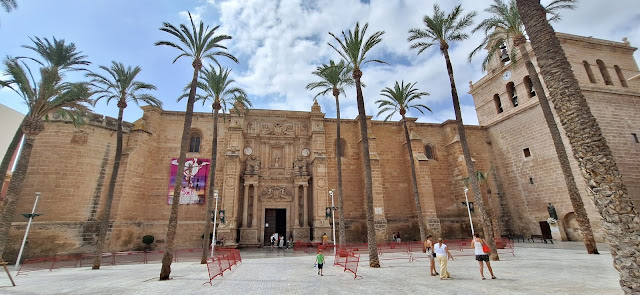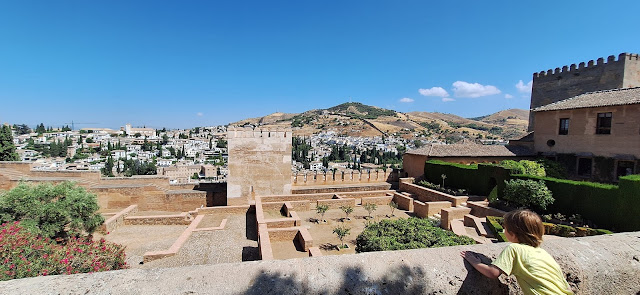It was Tuesday 20 August. We all woke up
incredibly late. I couldn’t believe Dainoris and Milda had actually remained in
bed until well after 9… then I remembered we were one hour ahead of Portugal.
Although to their credit, they did stay in for more than half an hour longer
than usual. I guess we all needed it – nobody had slept particularly well for
the last few days, but I’m guessing the full moon had something to do with
that. Livia usually looks after herself, but when she’s bored she might come to
wake us up. Not today though, she was last.
The itinerary for the day was this: we
would walk a kilometre to the Alcazar of Seville, a massive Moorish palace to
the south of the centre, and to break the journey for Milda, we would stop for
lunch on the way. In Spain, in many places, you need to book online well in
advance, especially in the summer, and lots of places ask for proof of ID,
which I find to be a total infringement on my privacy. Who on Earth do they
think we all are, to treat us with suspicion? This is one of the least
desirable things about life in Spain: the need to prove who you are for even
the simplest of things.
We spent the morning mentally preparing to
venture out in the August heat of Seville, one of the hottest cities on average
in Europe. When lunchtime came, we hit the streets and despite this city’s
reputation for being a cauldron of sticky heat and discomfort, it was
surprisingly bearable – more so than Valencia last summer, to be frank. We
walked along the narrow pedestrian streets of the Casco Antiguo before we
turned into the Plaza Nueva, where the city’s administrative buildings are
found. It, of course, has a number of shady trees and a statue of San Fernando
as its central point.

Just beyond the square, the grand
thoroughfare that leads to the cathedral opens up, but just before then is the
Calle Joaquin Guichot, and a row of very inviting-looking restaurants. The
first one was a place called El Favorito, which despite changing hands not long
ago, maintains its original décor. There are the high vaulted ceilings, a pink
marble counter which seemed fun to work on, the original dining tables and a
belle époque interior style with very colourful walls and floors. I have only
seen this type of design in northern and central Europe. It was not so full,
but it had a real buzz, and could easily have been a Grand Café in Prague,
Budapest or Paris.

The menu was astounding – great treats such
as roasted pepper salad, pisto andaluz (a type of ratatouille), goat cheese
croquettes, codfish with octopus ink-infused alioli, or just a plain ibérico
sausage. Fancy spinach with chick peas? Cuttlefish balls? Anchovies in vinegar?
They’ve got it. Their whole menu was a poem. And this is where I think the
Spanish have a great advantage over the Italians: the Italians named and
continue to name dishes (whole recipes) after the place they were created or
the person that created them, whereas in Spain many dishes are written on the
menu mainly with their ingredients. And this is how Spanish food can adapt and
improve.
I ate a salmorejo so thick, it was almost
the consistency of crème patissière. The portion of sausages, eggs, chips and
confit of onions that arrived for the children was so moresome that I forgot
about my own plate, especially as two of them decided it was “yucky” because it
was covered in onions. Ah well, more for me…
So after this feast of delights, we
stumbled, bloated and heavy, out into the hot Seville air towards the Alcazar,
along past this city’s immense cathedral, as well as a dozen emaciated horses
cruelly attached to tourist carriages, and found our way to the Lion Gate, the
entrance to the palace. We passed through security, a common measure these
days, and we found ourselves in one of the most impressive historical monuments
that exist anywhere on Earth. It is truly astounding, and to their credit, the
children found this place pretty awesome too.
I won’t go into detail, as the photos are
self-explanatory, but if you have never visited the Alcazar, you will not be
disappointed. The only bone of contention that I have is the internal
cafeteria, which is an utter disgrace. For five soft drinks, two coffees, three
Cornettoes and a couple of sad cakes that had sat in their display case, we
paid nearly 40 euro, which was scandalous.
The gardens were beautiful with their tall
palm trees, wandering peacocks and ceramic fountains. The interiors radiated
with richness and colour, with a deep attachment to their Islamic heritage. The
waters of the inner courtyards glistened with the perfect reflections of the
backgrounds. And even without the pushy, sharp-elbowed tourists that frequented
these places, the experience was just as amazing.
The impressions made this day I think will
be difficult to forget, and I hope all of the children will look back at this
experience with fondness. On the way back to our apartment, we passed a few
shops and made a rare foray inside to buy a few souvenirs. Now that we are
entering the final phase of our road trip, we can make a few exceptions. Until
now, we tried to save space and not clog up the car entirely, but it’s not such
a problem. We went back to the apartment and collapsed on the sofa, watched TV
and had some bread before they went to bed.
What a day.
Let me be clear here: this is not a promotional text on behalf of
Seville, I promise. But I have to declare that this is a magnificent city. Spain
has a wealth of cities that would obviously be the capital in about two dozen
other European countries. And Seville is one of them: when you walk around
this city, it has a host of grand buildings that stretch out well beyond just
the centre.
On Wednesday 21 August, we decided to take
in the city and get a feel of the place. Retracing some of the route back to
the Alcazar, we took several ways that we didn’t have the opportunity to visit
the day before. Despite the raging temperatures, it was surprisingly bearable.
Yes, leaving the house had been like switching on the hairdryer, but there was
a cool breeze that was blowing off the sea a little way further south.

At lunchtime, we found ourselves near the
place we had been to the day before. There are several in a row, so we decided
to try another one, virtually next door. The menu didn’t really set my pulse
racing, I’ll be quite frank about it, but I changed my mind when the food came
– it was beyond delicious. We ordered a tomato salad with the crunchiest
tomatoes possible, plus olive oil, garlic and chopped basil. We also asked for
some patatas bravas. Every place does these things differently, but in here,
the salsa brava had obviously been made using some of the other elements left
over from cooking, because it was rich, thick and warm. I personally opted for
the pork ribs, which had been slow cooked in wine to make a thick rich sauce. I
could have cut it with a plastic spoon, that’s how tender it was.

We passed by some shops to do some more
souvenir acquisition – the children had wanted some flamenco dolls. After a
brief rest at home, we went out to watch a flamenco show. For me, the evening
was a living hell. This type of show inevitably attracts the kind of tourist I
utterly despise, but we wanted the children to see some of the culture. The
woman selling the tickets a day earlier, which cost us over 80 euro for the
five of us, told us to get there about half an hour before the show to
guarantee some good seats, as it’s done on a first-come-first-served basis.
We did get there half an hour before the
6pm show, but she was frantically making some calls. Then she announced to us
that the show would be delayed by up to half an hour, because the Vuelta a
España was passing through Seville, and the artists, who lived outside the
city, were stuck in traffic. So to appease the children, we went for a drink at
a café thirty metres away. We returned less than half an hour later, and good
that we did, because people were being let in. I wanted the children to have
good seats because otherwise they wouldn’t be able to see, but the front rows
had been reserved.
I was furious.
Being told they were
first-come-first-served, no reservation, and then to find “RESERVED” on all the
seats at the front, I felt totally hoodwinked. When I delivered my complaint to
the same woman who had sold me the tickets, I was presented with the usual
generic apologies followed by a corporate smile. She offered us the higher
seats at the back, but if one adult sat in front, Milda would have a very
difficult time seeing anything. At the moment, the row was empty. But for how
long?

The show started and we thought that would
be that, but about 10 minutes after starting, in walked a family of four
including a huge, round-shouldered father, who put himself right in front of
Milda. Now I was really upset. They had come in, making a scene that there were
no seats with a decent view (HELLO…??? YOU ARRIVED TEN MINUTES LATE TO A SHOW
THAT HAD ALREADY BEEN DELAYED BY 20 MINUTES!!!) but despite the usher having
offered a seat in the central aisle near the back, he was still deeply
ungrateful and squished his enormous figure onto the seat in front of Milda.
I was sitting on a seat at the very back
behind Livia and Dainoris. Livia had started talking, saying that the footwork
of the flamenco dancer was too loud, which made a Chinese woman on the row next
to us talk directly to Livia telling her to be quiet.
Well…
I let it slip the first time, but the
second time I gave her an extremely barbed, highly-charged retort which kept
her quiet for the rest of the performance. I mean, the performance was really
really loud, so I don’t know what made her order Livia to be quiet. If you want
silence at a performance, go to the opera.
As I already said, this type of event
brings out the worst type of tourist. And here we had the culturally unaware,
the self-unaware and the kind of chap that flies Ryanair and demands an
upgrade, all in the same cluster of seats. It was the longest hour of the
entire road trip, and I was relieved to get out of there. We were all
particularly frazzled after all that, and went straight back to the apartment
to clear up and pack bags.
The day after, we would leave the relative
heat of Seville for the mountains of the Sierra Nevada.
EXTRA PHOTOS:

















































